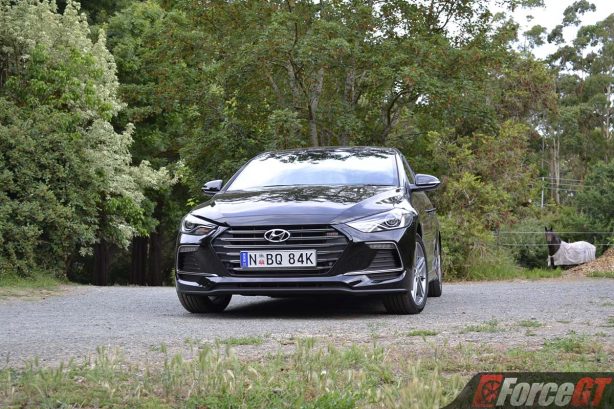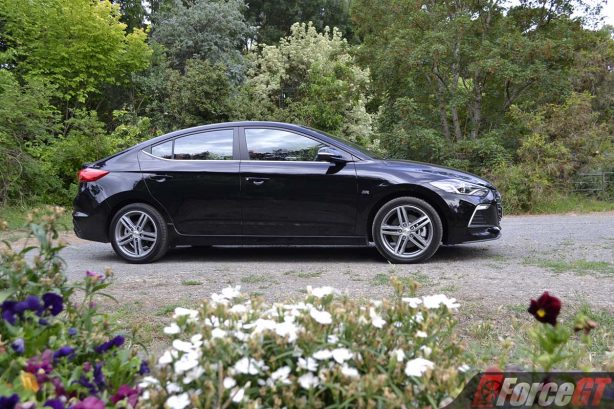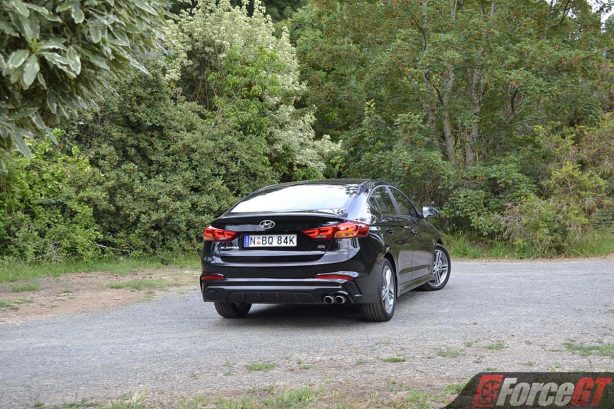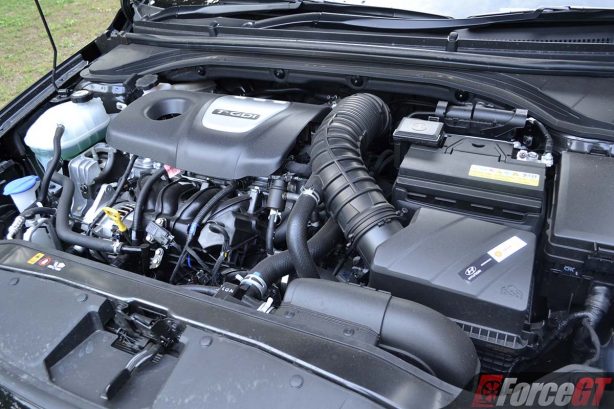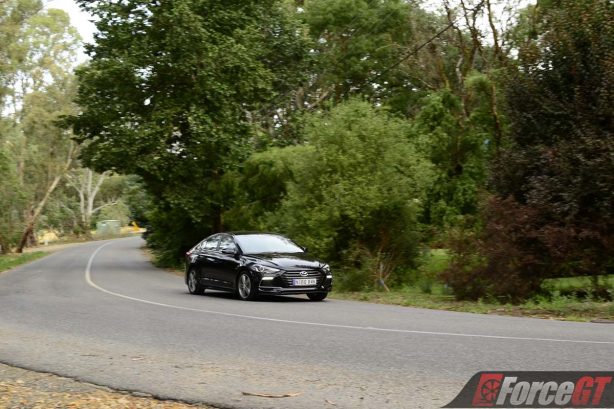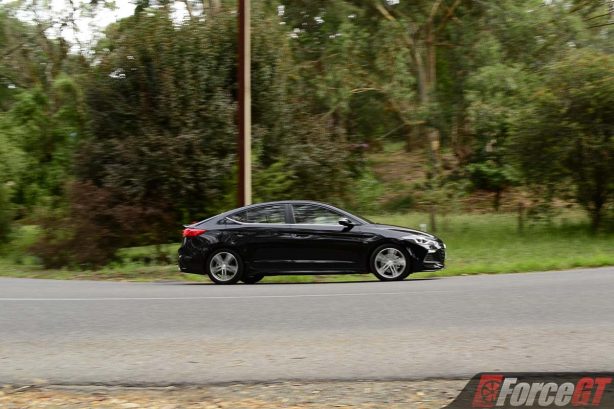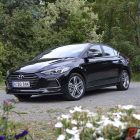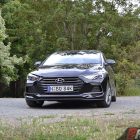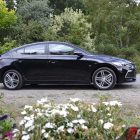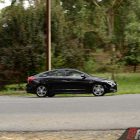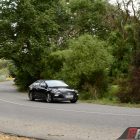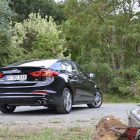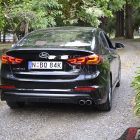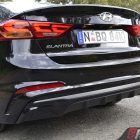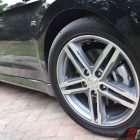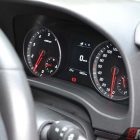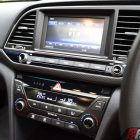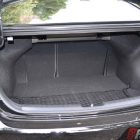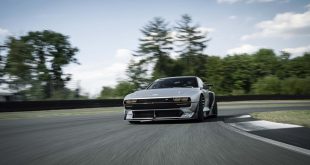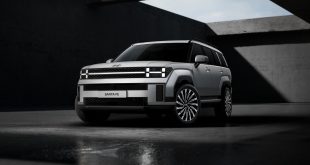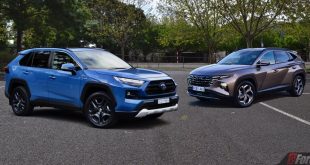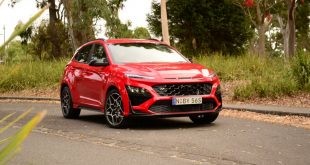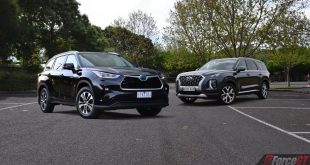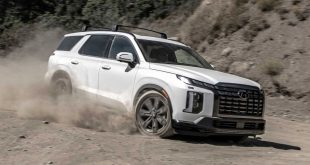Reliability – Tick. Build quality – Tick. Design – Tick. Safety – Tick. Having ticked all those essential boxes, Hyundai is now working on ticking the final and hardest box yet – fun to drive.
Dominated by the Europeans and Japanese, the affordable sports or performance car segment has never been more exciting and now there is a new contender – the 2017 Hyundai Elantra SR Turbo.
While the new Elantra launched last year rides and handles beautifully, and will get you to your destination comfortably, it just isn’t the most engaging or fun to drive vehicle for those wanting a bit more from their car. This is where the new Elantra SR Turbo steps in.
Following on the footsteps of the Veloster SR and i30 SR, the Elantra SR isn’t just a styling exercise, although the standard 17-inch alloy wheels, more dynamic body kit and head and taillights with more bling do make it look agreeably sportier than the bread and butter model.
Like the standard Elantra, the SR Turbo rides on an all-new platform that also underpins the next-generation i30 launching mid-year. Compared to the standard variants, it also scores a more sophisticated multi-link independent rear suspension (as opposed to a torsion beam setup) with bespoke Australian sports-tuned dynamics.
At the heart of the car is a 1.6-litre T-GDi Gamma turbocharged four-cylinder petrol engine (shared with the Veloster SR Turbo) that delivers 150kW at 6,000rpm and 265Nm of torque from 1,500 – 4,500 rpm, giving the car a handy 34 per cent more power and 38 per cent more torque respectively than the Elantra Active and Elite’s 2.0-litre MPi petrol engine.
Boasting direct-injection, Dual Continuously Variable Valve Timing, electronic throttle control, roller timing chain and innovative anti-friction coatings, the engine is matched with either a 6-speed manual as tested here, or an optional 7-speed dual-clutch transmission.
Apart from the new sports suspension, the flagship Elantra also gains bigger 305mm x 25mm ventilated front brakes and a more direct steering, along with extensive local optimisation work that saw Hyundai’s Australia’s chassis tuning engineers exhaustively assessed 50 separate suspension combinations, built and tested 28 different front and rear dampers, three rear anti-roll bars and 10 different sets of springs.
The result is one of the most well sorted and connected Hyundai’s I have driven to date.
Its body control is tight with pleasingly little understeer and good mid-corner response. Turn-in is eager with the front end giving more initial bite, while the faster rack (reduced to 2.57 turns lock-to-lock) and acceptable grip from the 225/45 R17 Hankook Ventus Prime tyres also give the car an agile feel. The car feels more alert and corner exits can be taken surprisingly early without the car threatening to run wide.
Hyundai should also be applauded for offering a six-speed manual with the SR Turbo – a rarity these days. And it is a good one, too. It has that precise and wonderfully oily Germanic slickness usually found in Volkswagens and Audi’s, matched with a light clutch that makes rowing through the gears gratifying.
What lets the otherwise sporty nature of the car down is the slight inconsistency in the steering weighting just off centre. It is a precise tiller but isn’t as communicative as those from the hot hatch club.
The Elantra Turbo doesn’t feel fast like some of its rivals, either, due to mild turbo lag low down, but once on the boil at above 2,000rpm, it’s punchy enough to do the SR Turbo badge justification.
The car’s throttle response is also not as sharp as Europe’s best but the major disappointment is its engine note, or lack of. It just doesn’t sound sporty enough. And while most enthusiasts would throw eggs in my face for suggesting a sound generator, but that would at least give the car a more tuneful character. The same goes for the rather pedestrian exhaust note that is devoid of the bassy throb of a hot hatch.
The Elantra SR Turbo inherits the regular models’ relatively refined cabin, although there’s slight tyre noise at freeway speeds. It also can’t quite match the excellent refinement of the Peugeot 308 GTi nor the Volkswagen Golf GTI.
Inside, it sits four comfortably and when equipped with the red leather trim as in our test car, is unmistakably sporty. It is complemented by a pair of sports front seats, a beautiful flat-bottomed steering wheel, alloy pedals, carbon-look trims, red contrast stitching and black headlining. The sporty flavour is further enhanced with red needles in the instrument cluster that rest at six o’clock positions.
Some will note the ‘Sport’ embroidered logo on the front seats instead of ‘SR’. That’s due to its US market origin where the car is known as the Elantra Sport.
The Elantra SR Turbo is surprisingly frugal for a ‘mild’ performance car, returning a combined test average of 7.5L/100km, against a claim of 7.7L/100km. This is despite a lack of any fuel saving technologies such as engine stop/start. What’s more, it will happily slurp on regular unleaded unlike most of its rivals which need the more expensive premium juice.
Verdict
Design and Comfort: 8.0/10
Performance and Handling: 8.0/10
Quality: 8.5/10
Economy: 8.0/10
Equipment and Features: 8.0/10
The Hyundai Elantra SR Turbo is unquestionably the most engaging small car to ever come out of the Korean brand.
We also applaud Hyundai for offering the only affordable sports infused small sedan in the market, and for throwing in a slick 6-speed manual as well.
Has it ticked the ‘fun to drive’ box? Yes and No.
The Elantra SR Turbo has pretty much nailed it on the handling and dynamics front but as a complete sports package, it isn’t quite there yet. We would like to see, or more appropriately, hear, a more tuneful engine and exhaust note for that truly engaging experience.
Pros:
- Agile handling and good dynamics
- Value for money
- Slick 6-speed manual
Cons:
- Engine and exhaust notes not sporty
- Steering could be more communicative
2017 Hyundai Elantra SR Turbo manual pricing and specifications
| Pricing (Excluding on-road costs): | From $28,990 As tested: $29,780 Tested options: · Red leather upholstery: $295 · Metallic paint: $495 |
| Warranty: | 5 years/unlimited kilometres |
| Warranty Customer Assistance: | 1 year roadside assist |
| Country of Origin: | South Korea |
| Service Intervals: | 12 months/15,000km |
| Engine: | 1.6-litre direct-injected, turbocharged in-line 4-cylinder petrol: 150kW @ 6,000rpm, 265Nm @ 1,500-4,500rpm |
| Transmission: | 6-speed manual/7-speed dual-clutch |
| Drivetrain: | Front-wheel drive |
| Power-to-weight Ratio (W/kg): | 110.7 |
| Combined Fuel Consumption (L/100km): | Claimed: 7.7 / Tested: 7.5 |
| RON Rating: | 91 |
| Fuel Capacity (L): | 50 |
| Safety: | 5-star ANCAP, 6 airbags, ESC, TCS, ABS, EBD, VSM, Hill-start Assist, Rear-view camera, front and rear parking sensors, Blind Spot Detection (BSD), Lane Change Assist (LCA), Rear Cross Traffic Alert (RCTA), LED DRL, Bi-Xenon headlights, LED taillights, ISOFIX |
| Dimensions (L/W/H/W-B) mm: | 4,570/1,800/1,440/2,700 |
| Kerb Weight (kg): | 1,385 |
| Towing Capacity (kg): | N/A |
| Entertainment: | 7-inch touchscreen with MP3, iPod, Bluetooth, Apple CarPlay and Android Auto, 6-speakers |
Competitors: Nissan Pulsar SSS, Mazda3 SP25, Honda Civic RS, Renault Megane GT, Ford Focus ST, Peugeot 308 GTi, Volkswagen Golf GTI
 ForceGT.com Car News, Car Reviews, Video Reviews, Tuning and much more.
ForceGT.com Car News, Car Reviews, Video Reviews, Tuning and much more. 